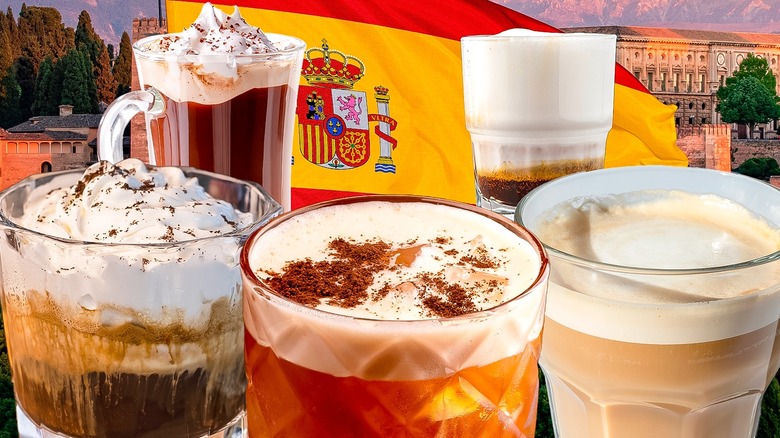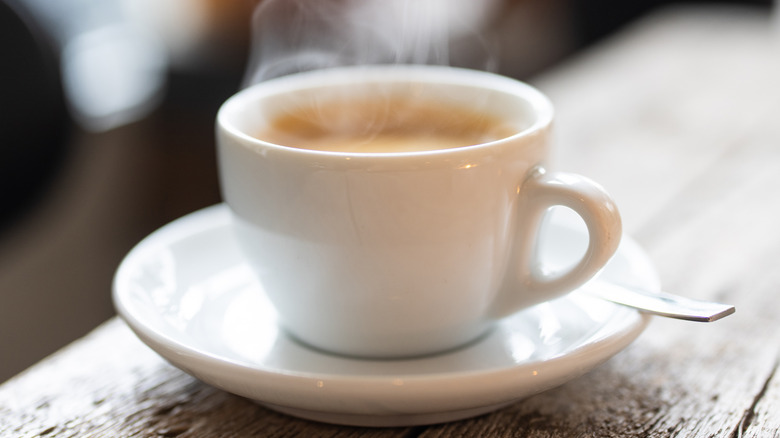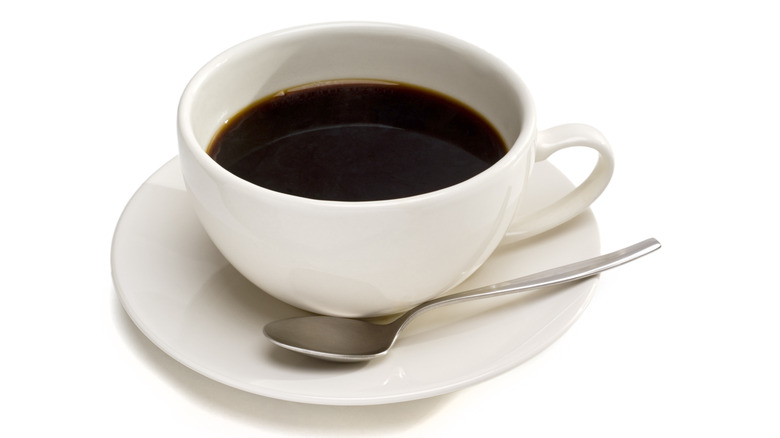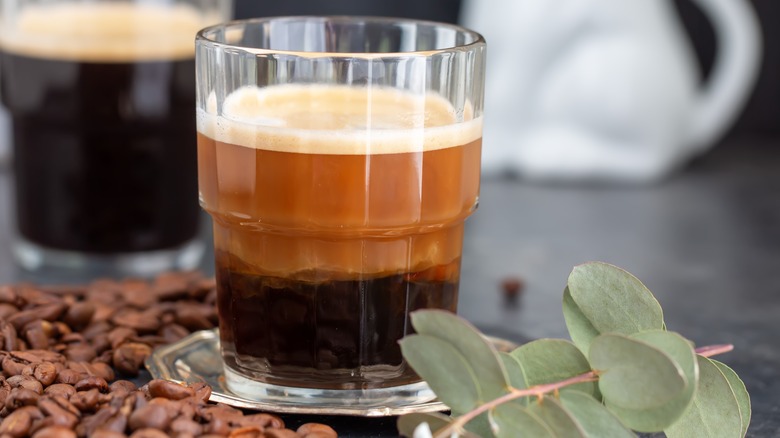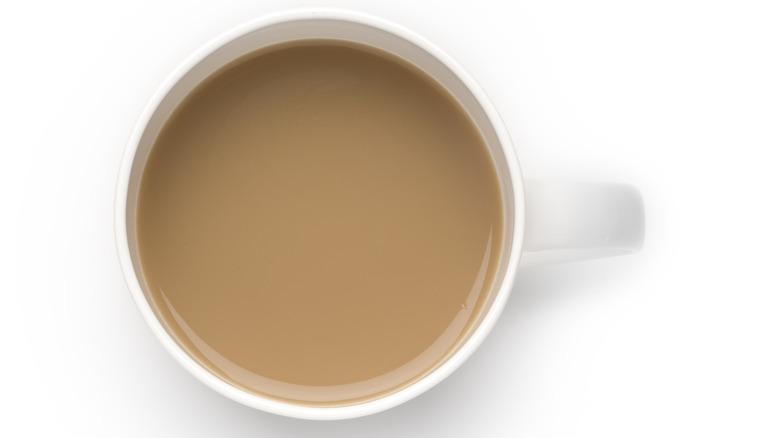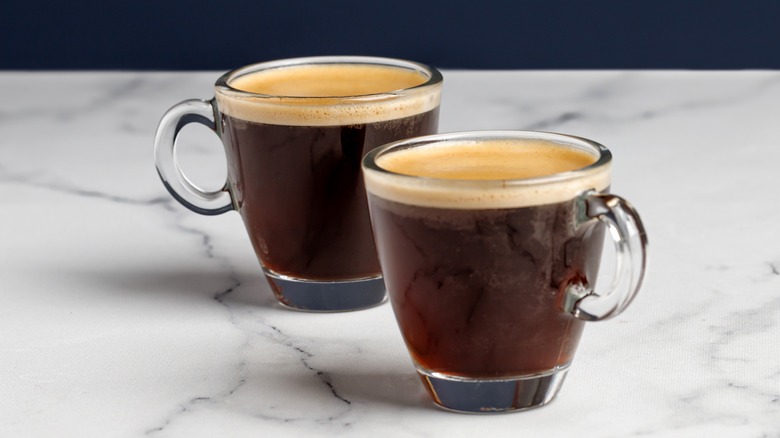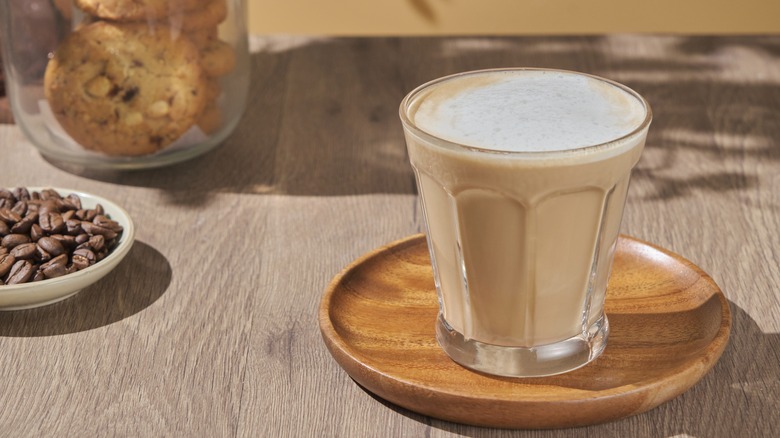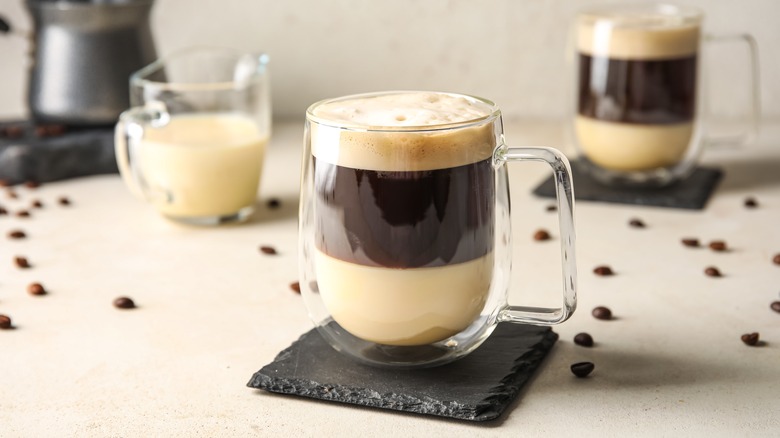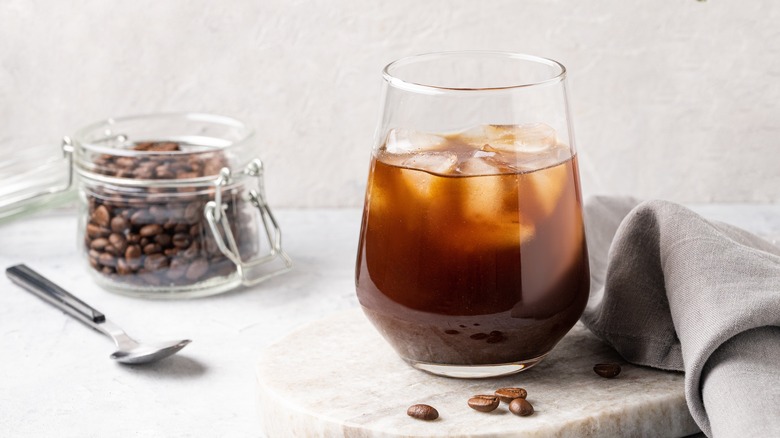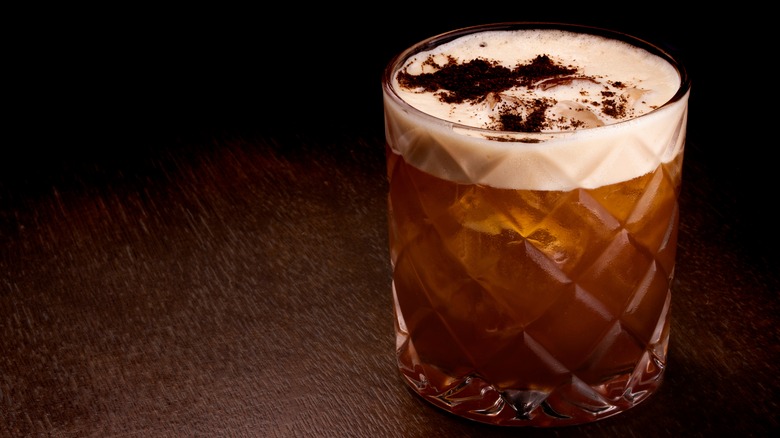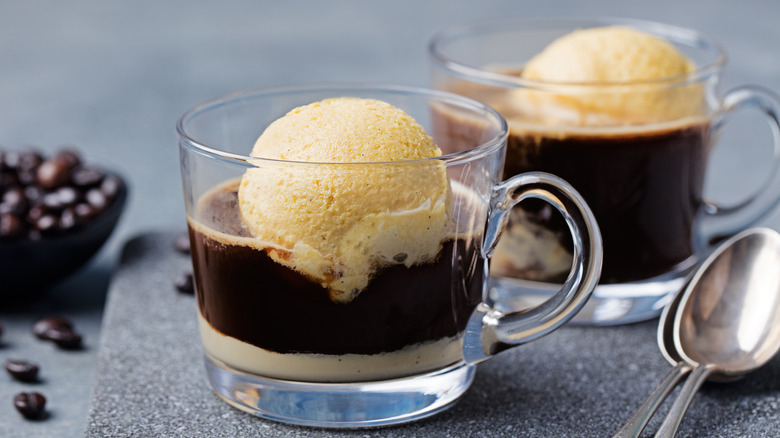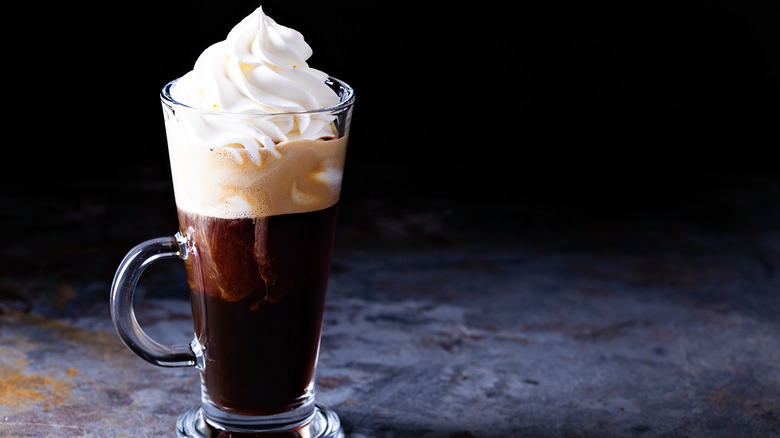11 Spanish Coffee Drinks You Should Try At Least Once
Along with other European culinary hard hitters like France and Italy, Spain has a rich coffee tradition dating back hundreds of years — more than 250 years, to be exact. In fact, the first Spanish cafe was opened in Madrid in 1764. It wasn't long before similar establishments started popping up in cities like Barcelona, Valencia, and Bilbao. Nowadays, Spaniards consume a lot of coffee, and a lot of different types of it, too.
Given how much coffee the Spanish drink, it should come as no surprise that they've gotten creative with their coffee beverages. Sure, you'll find beverages similar to espressos, Americanos, and lattes, but you'll also find all kinds of unique variations. Take the café bombón, for example. This sweet treat blends espresso with sweetened condensed milk for an off-the-charts flavor experience. And that's just the beginning. Follow along as we explore Spanish coffee drinks you should try at least once.
Café solo
In Spain, "solo" means "alone," and when it comes to coffee, ordering a café solo signifies your desire for an espresso in its purest form. If you ask for a café, this is what you'll receive. So, be cautious if you're seeking a milder, more diluted brew (we'll delve into that option later). More than a concentrated shot of caffeine, the café solo embodies the essence of Spanish coffee culture. Indeed, it's what you'll see Spaniards sipping on first thing in the morning, after lunch, and late into the afternoon.
Much like ordering espresso in other parts of the world, the Spanish version is served strong in a small ceramic cup. Beyond that, don't expect any embellishments. You might get a couple of sugar cubes, but that's about it. And while Spain's most basic coffee beverage closely resembles its Italian counterpart, the two aren't identical. Notably, the Spanish version is slightly taller, filling up half the cup or more.
Café americano
In the realm of international coffee culture, names may differ from country to country, but the essence of the brew remains the same. Just as the Italians have their caffè Americano and the French their café Américain, the Spanish offer up café Americano. Regardless of what you call it, this coffee order is a shot of espresso diluted with hot water.
The resulting beverage is milder-tasting than espresso, but with about the same amount of caffeine. With that said, the flavor is usually more intense than the drip coffee most Americans are accustomed to making at home. It's also important to keep in mind that Americanos are served straight up. If you want milk in your coffee, you're better off ordering a café con leche (more on that later).
This rather dull-sounding coffee traces its history back to World War II. At that time, American G.I.s in Italy were having a tough time adjusting to the strength of Italian espresso. In an ingenious act of coffee diplomacy, Italian baristas started diluting their brews with hot water to make them more palatable. The American soldiers took to the novel beverage right away and the rest is history.
Café cortado
"Cortado" translates to "cut," and that's just what Spanish baristas do when making this Basque-country staple: They cut the acidity of the espresso with a bit of milk. As a result, a cortado has a milder, sweeter taste than a plain espresso. It also has a smoother, creamier mouthfeel than an unadulterated espresso. The proportions vary from coffee shop to the next, but the general rule of thumb involves filling a small glass ¾ of the way with espresso and the remaining quarter with steamed milk.
If this is starting to sound like a macchiato, you're not wrong. The two coffee beverages do have quite a bit in common. After all, both are espresso-based and incorporate milk. However, they differ in both the amount and type of milk used. A cortado is made with a healthy dose of steamed milk, whereas a macchiato features just a dollop of milk foam on the surface of the espresso.
Café con leche
Coffee drinks don't get simpler (or tastier) than a café con leche. This classic Spanish coffee is made by combining equal amounts of coffee and milk. The final product is served in a large, latte-sized cup that's perfect for lingering over. Spaniards tend to take their café con leches first thing in the morning with breakfast, but they also enjoy them alongside sweet treats in the afternoon.
Keep in mind that most cafes will scald the milk automatically. However, you may be asked if you want cold milk (leche fría) or lukewarm milk (leche templada), instead. Speaking of milk, this crucial ingredient is what differentiates Spain's café con leche from France's café au lait. A café con leche uses scalded milk (milk heated to nearly boiling), whereas a café au lait employs steamed milk. As a result, the café con leche has a smooth surface, while the café au lait has a foamy crown. The other main difference is the type of coffee. The Spanish version relies on espresso, but the French one opts for drip coffee.
Café descafeinado
Whether you're sensitive to caffeine or just don't want to interrupt your sleep, there are all kinds of reasons to take your coffee decaffeinated. If you count yourself a member of either camp, then we have good news and bad news. The good news is that you'll be able to find decaffeinated coffee in Spain. The bad news is that it probably won't wow you.
While some coffee shops will have decent decaffeinated coffee beans on hand, allowing you to order any espresso-based coffee without the fear of jitters, that's not always the case. In fact, many cafes in Spain only have instant decaffeinated coffee (known as café descafeinado de sobre). If that's the case, you'll be presented with a cup of hot milk or water and a packet of coffee granules. Not exactly enticing. On the off-chance you stumble upon a cafe with decaf coffee beans, the barista will ask you if you want packet or machine coffee (¿de sobre o de máquina?), so be prepared to dust off your high school Spanish before ordering.
Manchado (leche manchada)
The manchado is a drink that skews more towards milk than coffee. In fact, this drink, which also goes by the name of "leche manchada," meaning "stained milk," is made up almost entirely of milk. A few drops of espresso are added to a tall glass of milk, giving it a tan hue and a pleasant coffee-infused aroma. But even with the presence of coffee, it's the sweetness from the warm milk that stands out the most.
Coffee fanatics might find this order strange, but a manchado is the perfect drink for those who enjoy the concept of coffee more than the actual experience of drinking it. Plus, the negligible amount of caffeine in a manchado makes it an ideal choice for children or those sensitive to caffeine. Although quite similar to a latte macchiato, we don't advise using that term. It's not very common in Spain and you might end up with a drink that's more coffee than milk (aka the opposite of what you want) if the barista or waiter misunderstands.
Café bombón
From arroz con leche and churros to flan and crema Catalana, Spain's desserts present countless opportunities to indulge your sweet tooth. But what if we told you that you could satisfy your sugar and coffee cravings in the same cup? That's right, when you order a café bombón, you get to enjoy the sugary goodness of sweetened condensed milk in the same cup that you drink your espresso out of.
This beloved Spanish coffee drink comes from Valencia, a town on Spain's eastern coast. There (and in Catalonia) you'll also find it referred to as a "biberón" or a "baby bottle." The bombón is made with equal parts sweetened condensed milk and espresso. To make it, the condensed milk is layered on the bottom of a clear glass, and then topped with espresso before serving. If you're lucky, some of the espresso crema will still be present when you receive your order, resulting in a tri-colored coffee beverage that looks oh-so-luxurious. Once you've snapped a photo for the 'Gram, stir the two ingredients together and take a sip of this delightfully sweet coffee treat.
Café con hielo
With average daily temperatures in August reaching well into the '80s, it only makes sense that Spaniards lean on chilly liquid refreshments to keep them hydrated during the summer months. Enter café con hielo, Spain's answer to iced coffee. In Catalonia, you'll hear it called cafè amb gel, whereas Valencians refer to it as café del temps or café del tiempo. This drink is extremely popular in the summer months, but not so much the rest of the year. So, if you visit Spain in October, for example, you'll probably get some strange looks if you order one.
Now, before you get all excited about finding iced coffee in Europe, we should warn you that café con hielo isn't exactly like the cold brew you're used to ordering at Starbucks. Rather than come premixed, Spain's version comes in two cups: one containing an espresso and the other a couple of iced cubes. From there, it's up to you to sweeten the coffee and pour it over the iced cubes. Besides this basic version, there are some variations worth knowing. For instance, the Valencian version usually comes with a lemon slice. And some bars might give you cold milk on the side, but you'll have to ask for it, and it's not guaranteed.
Carajillo
When you're in the mood for something a bit ahem, stronger than plain coffee, there's the carajillo, a coffee cocktail made with hot espresso and your choice of liqueur (brandy, whisky, rum, or anisette are the most common options). Some bars make carajillos by setting the alcohol on fire before adding the coffee. This burns off most of the booze leaving just the aroma of the liquor behind. Others combine the two ingredients sans flame in a one-to-three ratio (one part liquor to three parts coffee).
There are several theories about the origins of the carajillo. Some believe the drink originated in Spanish-run Cuba. According to the legend, Spanish soldiers would stir local rum or brandy into coffee in order to give themselves courage going into battle. A second theory claims that the Catalunya region of Spain invented the drink. Workers were given rum-infused coffee to help them finish the day full of energy. The last theory is that time-pressed transportation workers from Barcelona would mix their coffee and liquor as a way of keeping on schedule. After swizzling their drinks, they'd say "que ara quillo" a phrase that means "I'm leaving" and sounds quite a bit like the modern name for the drink.
Blanco y negro
More of a dessert than a coffee drink, blanco y negro (black and white) is a summertime treat made by pouring a steaming shot of espresso over a scoop of creamy vanilla ice cream. Other flavors of ice cream can be used, but they should be light-colored in order to honor the drink's name. If you're thinking that a blanco y negro sounds an awful lot like an affogato, then you're right — the two sweet concoctions are basically the same thing.
With that said, the Spanish have found all kinds of ways to make this hot weather indulgence unique. In addition to the classic version, they also have a blended option in which coffee is either blended with ice or frozen and blended. The blended option is sometimes called a granita and it has the same frosty texture you find in Italian ice or slushies. It's usually served topped with ice cream and either cream or leche merengaga (meringue milk), adding yet another layer of indulgence to this delightful treat.
Café Vienés
Inspired by Vienna's opulent coffee culture, café Vienés is a crave-worthy drink made using steaming hot espresso, velvety whipped cream, and a decadent chocolate garnish. To make it, the espresso is poured into a tall handled glass, followed by about an ounce of hot water. Next, the glass is filled to the brim with whipped cream before getting dusted with cocoa powder or chocolate shavings. The result is a three-layered masterpiece that's the perfect companion for people watching at Puerta del Sol square.
Once you know the recipe, it's easy to see how this scrumptious beverage made its way through other European countries like Spain, France, and Italy. While the Spanish and French versions remain faithful to the original recipe, the Italian version, known as espresso con panna, is petite in comparison. It consists of an espresso in a 2-ounce demi-tasse cup adorned with a simple dollop of whipped cream.
